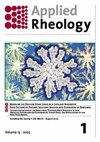Correlating Coating Quality of Coverage with Rheology for Mica-Based Paints
IF 1.8
4区 工程技术
Q1 MECHANICS
引用次数: 1
Abstract
Abstract This paper examines the relationship between rheology and the qualitative appearance of dried, mica-based paint coatings used in the aerospace industry. The goal is to identify key rheological characteristics indicative of poor coating visual appearance, providing a screening tool to identify unsatisfactory paint formulations. Four mica paints were studied, having coating visual appearances ranging from very poor to very good. Strain sweeps indicated that the poor-quality paints have a smaller % strain midpoint in the linear visco-elastic range; while the good-quality paints have a lower G’/G” cross-over point in frequency sweeps. Thixotropy experiments utilizing single and multiple-loop hysteresis cycles plotting shear stress as a function of shear rate showed that the base mica paints with good appearance had nearly constant, reversible profiles in the forward and the backward directions; while the mica paints with poor appearance were irreversible with a noticeable gradual change in shear stress as more loops are run. The difference in area between the forward and the reverse curves was determined, leading to a quantifiable criterion that can differentiate good paints from poor paints with significance testing. This work would establish the first rheology model using hysteresis loops to predict the visual properties of mica-based paints.云母基涂料覆盖质量与流变性的关系
摘要:本文研究了航空航天工业中使用的干燥云母基涂料的流变性和定性外观之间的关系。目的是确定表明涂层视觉外观不良的关键流变特性,提供筛选工具来识别不满意的涂料配方。研究了四种云母涂料,它们的涂层视觉外观从很差到很好不等。应变扫描表明,质量差的涂料在线性粘弹性范围内的%应变中点较小;而质量好的涂料在扫频时具有较低的G′/G′交叉点。利用单回线和多回线迟滞循环绘制剪切应力随剪切速率的函数的触变性实验表明,具有良好外观的基础云母涂料在正向和反向上具有几乎恒定的可逆轮廓;而外观较差的云母涂料是不可逆的,随着更多的循环运行,剪切应力会发生明显的逐渐变化。确定了正向和反向曲线之间的面积差异,从而得出了一个可量化的标准,可以通过显著性测试区分好油漆和差油漆。这项工作将建立第一个使用磁滞回线来预测云母基涂料视觉特性的流变模型。
本文章由计算机程序翻译,如有差异,请以英文原文为准。
求助全文
约1分钟内获得全文
求助全文
来源期刊

Applied Rheology
物理-力学
CiteScore
3.00
自引率
5.60%
发文量
7
审稿时长
>12 weeks
期刊介绍:
Applied Rheology is a peer-reviewed, open access, electronic journal devoted to the publication in the field of applied rheology. The journal provides the readers with free, instant, and permanent access to all content worldwide; and the authors with extensive promotion of published articles, long-time preservation, language-correction services, no space constraints and immediate publication.
 求助内容:
求助内容: 应助结果提醒方式:
应助结果提醒方式:


